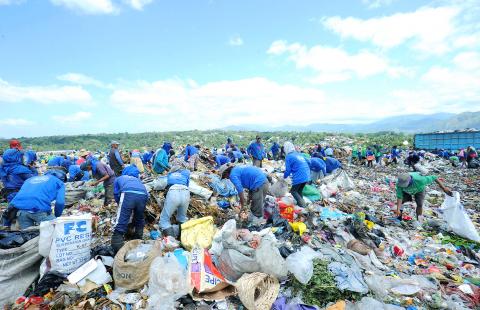Teresita Mabignay does her ironing using free electricity on the slope of a garbage dump, an unlikely beneficiary of efforts to turn the Philippines’ growing trash problems into a clean energy windfall.
Mabignay lives at the base of one of Manila’s largest landfills, which was the first in the country to have its methane gas converted into power as part of the UN’s Clean Development Mechanism program aimed at tackling climate change.
Decomposing trash produces methane — one of the greenhouse gases scientists blame for global warming — and turning it into electricity saves it from rising up into the atmosphere while reducing the need to burn fossil fuels. The methane is captured with pipes that are dug into the landfill, similar to wells that extract gas from under the ground or ocean. Methane is then sucked down to a power station at the bottom of the dumpsite and pumped into electricity generators.

Photo: AFP
For the past few years, Mabignay and other housewives from the slum community at the bottom of the Payatas Landfill have been given free access to the power at a hall built at the dumpsite.
“It really helps because it cuts down on our electricity bills ... sometimes we use the savings to buy food,” said Mabignay, 50, whose husband earns the equivalent of about US$200 a month working as a security guard at the dumpsite.
The company behind the project, Pangea Green Energy Philippines Inc, could afford to be generous with its electricity as it was earning hundreds of thousands dollars to capture and convert the gas.

Photo: AFP
Under the UN program, industrialized countries can meet their Kyoto Protocol commitments to cut greenhouse gas output by funding projects that reduce emissions in developing nations such as the Philippines.
Companies in developing countries earn credits for reducing emissions, each equivalent to 1 tonne of carbon dioxide. The credits are then sold to companies, institutions or governments in industrialized countries to offset their emissions.
Pangea president Jennifer Fernan Campos said the Payatas energy project was set up to take advantage of the UN scheme, with the first kilowatts generated in 2008.
“We are also very gratified to be helping the environment and the community. In our own little way, we are mitigating greenhouse gas emissions,” she said.
Thousands of renewable energy projects in developing countries have been registered under the program since it began in 2005, including wind farms and solar stations.
There have also been many waste-to-energy projects, with four others in the Philippines starting up after the pioneering Pangea operation, industry Web site www.cdmpipeline.org said.
However, the market price for each tonne of greenhouse gas that companies save started dropping sharply in 2010, partly because of the economic meltdown in Europe, which was the biggest source of revenue.
“Our rate is a floating one so when the market collapsed, we suffered,” Fernan Campos said, adding that they made the mistake of not locking in a higher price when they had the chance.
Industry experts have warned the carbon-trading scheme is in danger because of the collapse in prices, and many clean energy projects face an uncertain future.
However, Fernan Campos said the Payatas project had become commercially viable without the UN-channeled money.
She said Pangea this month expanded capacity from 200 kilowatts to 1 megawatt, and began selling directly onto Manila’s electricity grid.
Previously, the electricity generated at Payatas had just been used to power operations at the landfill and for the nearby slum communities via the ironing project and street lights.
The amount of greenhouse gases that are now being saved at Payatas is the equivalent to taking 18,000 cars off Manila’s roads, Fernan Campos said.
She said that the project had a host of other environmental benefits, including less direct air pollution for people living close by. The extracted methane gas also no longer threatens to contaminate the water system.
Nevertheless, Greenpeace and some other environmental groups oppose such projects, saying that their “green” credentials are often exaggerated and that they create a financial incentive for more trash to be dumped.
“The only way to address the issue of methane generation from waste is to stop the rubbish going to the landfill in the first place,” Greenpeace Philippines program manager Beau Baconguis said. “Having such projects in place encourages the generation of waste, rather than eliminating it, because you need waste to run the facility.”
Baconguis said there was no vision from the Philippine government to reduce waste and that Manila’s approximately 12 million residents were producing between 6,000 and 8,000 tonnes of trash every day.
However, Fernan Campos insisted that Pangea was not lobbying for or encouraging more waste to be dumped at Payatas. She said the local government had implemented recycling and other waste reduction policies in recent years that had seen the amount of trash going into the landfill drop from 1,800 tonnes a day to 1,200.
“We are just clearing whatever is there and helping the environment at the same time,” she said.

To many, Tatu City on the outskirts of Nairobi looks like a success. The first city entirely built by a private company to be operational in east Africa, with about 25,000 people living and working there, it accounts for about two-thirds of all foreign investment in Kenya. Its low-tax status has attracted more than 100 businesses including Heineken, coffee brand Dormans, and the biggest call-center and cold-chain transport firms in the region. However, to some local politicians, Tatu City has looked more like a target for extortion. A parade of governors have demanded land worth millions of dollars in exchange

An Indonesian animated movie is smashing regional box office records and could be set for wider success as it prepares to open beyond the Southeast Asian archipelago’s silver screens. Jumbo — a film based on the adventures of main character, Don, a large orphaned Indonesian boy facing bullying at school — last month became the highest-grossing Southeast Asian animated film, raking in more than US$8 million. Released at the end of March to coincide with the Eid holidays after the Islamic fasting month of Ramadan, the movie has hit 8 million ticket sales, the third-highest in Indonesian cinema history, Film

Taiwan Semiconductor Manufacturing Co’s (TSMC, 台積電) revenue jumped 48 percent last month, underscoring how electronics firms scrambled to acquire essential components before global tariffs took effect. The main chipmaker for Apple Inc and Nvidia Corp reported monthly sales of NT$349.6 billion (US$11.6 billion). That compares with the average analysts’ estimate for a 38 percent rise in second-quarter revenue. US President Donald Trump’s trade war is prompting economists to retool GDP forecasts worldwide, casting doubt over the outlook for everything from iPhone demand to computing and datacenter construction. However, TSMC — a barometer for global tech spending given its central role in the

Alchip Technologies Ltd (世芯), an application-specific integrated circuit (ASIC) designer specializing in server chips, expects revenue to decline this year due to sagging demand for 5-nanometer artificial intelligence (AI) chips from a North America-based major customer, a company executive said yesterday. That would be the first contraction in revenue for Alchip as it has been enjoying strong revenue growth over the past few years, benefiting from cloud-service providers’ moves to reduce dependence on Nvidia Corp’s expensive AI chips by building their own AI accelerator by outsourcing chip design. The 5-nanometer chip was supposed to be a new growth engine as the lifecycle